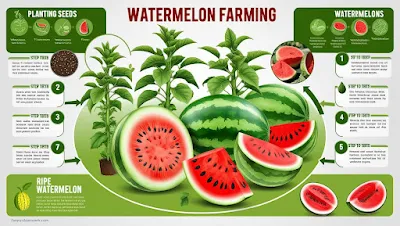Comprehensive Guide to Watermelon Farming
Watermelon farming is a lucrative agricultural venture that requires strategic planning, proper soil preparation, and careful maintenance to achieve high yields. This fruit, known for its refreshing taste and high water content, thrives in warm climates and well-drained soils. In this comprehensive guide, we will cover the essential steps for successfully cultivating watermelons, from land preparation to harvesting and marketing. This guide includes SEO-friendly keywords such as watermelon farming, watermelon cultivation, best practices for growing watermelons, high-yield watermelon farming, and organic watermelon production to enhance search visibility.
Climatic and Soil Requirements
1. Climate Conditions
Watermelon grows best in warm temperatures ranging from 22°C to 30°C.
Requires long sunny days for optimal fruit development.
Sensitive to frost; best grown in spring and summer seasons.
2. Soil Requirements
-
🟢 Thrives in sandy loam or loose, well-drained soils with a slightly acidic to neutral pH range between 6.0 and 7.5—perfect for rooting deep and sweetening up the fruit.Organic-rich soil enhances fruit quality and yield.
Requires proper drainage to prevent root rot.
Land Preparation for Watermelon Cultivation
1. Clearing and Tilling
Remove weeds, stones, and debris from the field.
Plow the soil to a depth of 25–30 cm to ensure proper aeration and root penetration.
2. Soil Fertilization
Apply well-decomposed organic manure to enhance fertility.
Apply nitrogen, phosphorus, and potassium (NPK) fertilizers in balanced ratios suited to crop needs.
3. Creating Ridges and Mulching
Raised ridges or mounds help improve drainage.
Organic or plastic mulch retains moisture and suppresses weeds.
Seed Selection and Sowing
1. Selecting Quality Seeds
Choose disease-resistant and high-yielding varieties.
Hybrid seeds offer better growth and fruit quality.
2. Sowing Techniques
Maintain a spacing of 1-2 meters between plants.
Watermelon Plant Care
1. Irrigation Requirements
Requires adequate but not excessive watering.
Drip irrigation is recommended for efficient water use.
Reduce watering before fruit ripening to enhance sweetness.
2. Weed and Pest Control
Hand weeding or herbicides can eliminate weeds.
Common pests include aphids, beetles, and spider mites.
Opt for organic pesticides or implement Integrated Pest Management (IPM) techniques for sustainable pest control.
3. Fertilization Schedule
Apply nitrogen-based fertilizers during early growth.
Increase phosphorus and potassium during flowering and fruiting.
4. Pollination Enhancement
Bees and other pollinators play a vital role in fruit development.
Some farmers introduce beehives to improve pollination.
Disease Prevention and Management
1.Common Diseases
Fusarium wilt: Use disease-resistant varieties and crop rotation.
Anthracnose: Apply fungicides and maintain proper field sanitation.
Powdery mildew: Use sulfur-based fungicides for control.
Harvesting Watermelons
1. Maturity Indicators
Takes 75-100 days from planting to harvest.
A yellowing underside is a clear sign that the fruit is ripe and ready to harvest.
Produces a hollow sound when tapped.
2. Harvesting Method
Carefully harvest ripe watermelons by cleanly slicing them from the vine with a sharp knife, ensuring minimal stress to the plant for continued productivity.
Handle with care to prevent bruising and damage.
Post-Harvest Handling and Marketing
1. Storage and Transport
Store in cool, shaded areas to prolong freshness.
Use ventilated crates for safe transportation.
2. Marketing Strategies
Sell in local markets, supermarkets, or export.
Consider processing into juice, snacks, or value-added products.
Implement SEO-friendly online marketing strategies for better reach.
Watermelon farming is a rewarding venture with proper planning, care, and marketing. By following the best practices outlined above, farmers can maximize their yield, enhance fruit quality, and achieve greater profitability. Whether growing for local consumption or export, adopting modern techniques will ensure a successful watermelon harvest.
For higher search rankings, this guide has been optimized with relevant keywords, structured headings, and actionable farming tips to help farmers and agribusiness owners succeed in watermelon production.
